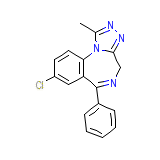Niravam




Niravam Brand names, Niravam Analogs
Niravam Brand Names Mixture
- No information avaliable
Niravam Chemical_Formula
Niravam RX_link
Niravam fda sheet
Niravam msds (material safety sheet)
Niravam Synthesis Reference
Niravam Molecular Weight
Niravam Melting Point
Niravam H2O Solubility
Niravam State
Niravam LogP
Niravam Dosage Forms
Niravam Indication
Niravam Pharmacology
Niravam Absorption
Niravam side effects and Toxicity
Niravam Patient Information
Alprazolam is used for the treatment of anxiety, panic disorder, and insomnia. Inform your physican if you are pregnant or nursing. Alprazolam may cause dizziness and drowsiness; use caution while driving or operating hazardous machinery. Do not take any other sedating drugs or drink alcohol while taking this medication. Alprazolam may be habit forming. Withdrawal symptoms may occur after you stop taking it. Alprazolam may be taken with or without food.
For All Users of Alprazolam
To assure safe and effective use of benzodiazepines, all patients prescribed alprazolam should be provided with the following guidance. In addition, panic disorder patients, for whom doses greater than 4 mg/day are typically prescribed, should be advised about the risks associated with the use of higher doses.
1. Inform your physician about any alcohol consumption and medicine you are taking now, including medication you may buy without a prescription. Alcohol should generally not be used during treatment with benzodiazepines.
2. Not recommended for use in pregnancy. Therefore, inform your physician if you are pregnant, if you are planning to have a child, or if you become pregnant while you are taking this medication.
3. Inform your physician if you are nursing.
4. Until you experience how this medication affects you, do not drive a car or operate potentially dangerous machinery, etc.
5. Do not increase the dose even if you think the medication "does not work anymore" without consulting your physician. Benzodiazepines, even when used as recommended, may produce emotional and/or physical dependence.
6. Do not stop taking this medication abruptly or decrease the dose without consulting your physician, since withdrawal symptoms can occur.
Additional Advice for Panic Disorder Patients
The use of alprazolam at doses greater than 4 mg/day, often necessary to treat panic disorder, is accompanied by risks that you need to carefully consider. When used at high doses greater than 4 mg/day, which may or may not be required for your treatment, alprazolam has the potential to cause severe emotional and physical dependence in some patients and these patients may find it exceedingly difficult to terminate treatment. In two controlled trials of 6 to 8 weeks duration where the ability of patients to discontinue medication was measured, 7-29% of patients treated with alprazolam did not completely taper off therapy. In a controlled postmarketing discontinuation study of panic disorder patients, the patients treated with doses of alprazolam greater than 4 mg/day had more difficulty tapering to zero dose than patients treated with less than 4 mg/day. In all cases, it is important that your physician help you discontinue this medication in a careful and safe manner to avoid overly extended use of alprazolam.
In addition, the extended use at doses greater than 4 mg/day appears to increase the incidence and severity of withdrawal reactions when alprazolam is discontinued. These are generally minor but seizure can occur, especially if you reduce the dose too rapidly or discontinue the medication abruptly. Seizure can be life-threatening.














